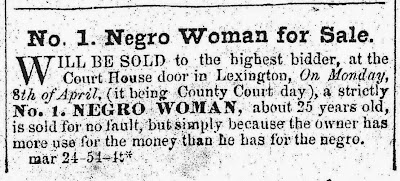Slavery in Antebellum America: All Night Forever
No issue has more scarred our country nor had more long-term effects than slavery. When we celebrate American freedom, we must also be mindful of the long and painful struggle to share in those freedoms that faced and continue to face generations of African Americans.


The Ledger and the Chain: How Domestic Slave Traders Shaped America
Review Slavery's roots from Time Period #2
The Cotton Gin MAKES SLAVERY PAY!!!!!
1 man can now produce 50 pounds of cotton in a day.
By 1830 America produces 50% of the world’s cotton, by 1850 America produces 75% of the world’s cotton.
Each slave becomes 50 times more valuable
Southern states want to expand West and bring slavery with them. This leads to the Compromise of 1850
Movement of Slaves from the Upper to the Lower South, 1790-1860



This viral photo changed America — in 1863
The powerful image conveyed the evils of slavery in a way that even the most potent
words of abolitionists William Lloyd Garrison or Harriet Beecher Stowe never could.

The Green Mile
The Spread of Slavery, 1790-1860

Generate Notes: The Horrors of Slavery - All Night Forever (4:30);
Fountain Hughes was born into enslavement in West Virginia. Growing up, he endured harsh conditions and cruel enslavers,
likening the experience to being in jail. His grandfather is believed to have been enslaved to Thomas Jefferson.
ANTEBELLUM SOUTH
"No day ever dawns for the slave," a freed black man wrote, "nor is it looked for. For the slave it is all night — all night forever." One white Mississippian was more blunt: "I'd rather be dead," he said, "than be a nigger on one of these big plantations." A slave entered the world in a one-room, dirt-floored shack. Drafty in winter, reeking in summer, slave cabins bred pneumonia, typhus, cholera, lockjaw, and tuberculosis. The child who survived to be sent to the fields at 12 was likely to have worms, rotten teeth, dysentery and malaria. Fewer than four in a hundred lived to be 60"
Source: Ken Burns , The Civil War, "All Night Forever"
ANTEBELLUM NORTH
"The most putrid urban carbuncle of all was the “Five Points” slum neighborhood of Manhattan, overcrowded with poor people from a variety of origins, native born and immigrant, notorious for its filth, disease, gangs, crime, riots, and vice. Charles Dickens, no stranger to urban wretchedness, expressed horror when he visited the Five Points. “From every corner as you glance about in these dark retreats” he wrote, “some figure crawls as if the judgement hour were near at hand, and every obscure grave were giving up its dead. Where dogs would howl to lie, women and men and boys would slink off to sleep. Forcing dislodged rats to move away in a quest for better lodgings.”
Source: Daniel Walker Howe What Hath God Wrought: The Transformation of America, 1815-1848, p. 530
Comments (0)
You don't have permission to comment on this page.